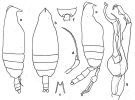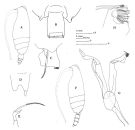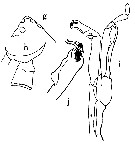|
|
 |
|
Calanoida ( Order ) |
|
|
|
Clausocalanoidea ( Superfamily ) |
|
|
|
Scolecitrichidae ( Family ) |
|
|
|
Scottocalanus ( Genus ) |
|
|
| |
Scottocalanus terranovae Farran, 1929 (F,M) | |
| | | | | | | Syn.: | ? Scottcalanus helenae (M): Tanaka, 1961 a (p.145) | | | | Ref.: | | | Farran, 1929 (p.209, 251, figs.F,M); Sewell, 1948 (p.553); Vervoort, 1965 (p.57, Rem.); Park, 1983 (p.198, 200, 210); Bradford & al., 1983 (p.116, 119, Rem.F,M, figs.F,M) |  issued from : G.P; Farran in British Antarctic (\"Terra Nova\") Expedition, 1910. Natural History Reports. Zoology. Vol. VIII; Crustacea, 1929. [p.251, Fig.18]. Female: a, habitus (lateral view); b, idem (dorsal view); c, rostrum (anterior view); d, fifth foot. Male: e, habitus (lateral view); f, 4th and 5th thoracic segment and first genital segment (dorsal view); g, fifth feet.
|
 Issued from : J.M. Bradford, L. Haakonssen & J.B. Jillett in Mem. N. Z. Oceanogr. Inst., 1983, 90. [p.120, Fig.74]. Female: A, habitus (lateral left side); B, genital segment (dorsal); C, genital segment and P5 (lateral left side); D, rostrum; E, P5 (other specimen). Male: F, habitus (lateral left side); G, P5; H, terminal part of left P5 exopod.
Female: - Posterolateral corners of last thoracic segment rounded in lateral view, but constricted in dorsal view and appearing like sharp spines. - head with triangular crest. - Rostrum with short rami and apical projections shorter than excavation. - Genital segment as long as following three segments, with genital protuberance. - P5 with terminal seta twice as long as leg, reaches distal end of urosomal segment 3. Male: - Rostrum as in female. - Fusion line between pediger segments 4 and 5 visible. - Right P5 endopod reaches beyond exopodal segment 1; exppodal segment 2 curved, exopodal segment 3 very small. Left P5 endopod shorter than exopodal segment 1; exopod at least 2-segmented.
|
 Issued from : O. Tanaka in Publ. Seto Mar. Biol. Lab., IX, 1, 1961 a. [p.144, Fig.107, g-j]. As Scottcalanus helenae Male. g, forehead (lateral); h, last thoracic segment and 1st and 2nd urosomal segments (lateral); i, P5; j, distal segment of left P5. - Last thoracic segment rather broadly rounded ; ventral margin of the segment much inflated when viewved from the side - Abdomen 5-segmented ; segments and caudal rami in the proportional lengths 18 : 24 : 23 : 21 : 7 : 7 = 100. Distal margin of the 2 nd to 4th segments fringed with fine teeth. segments. - A1 extends to the middle of the 4th abdominal segment. - Serration on the terminal spine of the exopod of P2 to P4 are more in number than those of the corresponding legs of the female [in S. helenae]. - Endopod of right leg of is long and curved towards the exopod, reaching about to the middle of the 2 nd segment of the exopod. Endopod of the left leg P5 short, about ½ the length of the 1st segment of the exopod of the same leg. 2 nd segment of the exopod of the left leg P5 dilated much on the inner margin. The 3rd segment of the exopod is represented by 2 curved stout spines, a pad of stiff hairs, and a leaf-like lamellous process with serrations on the distal end. For Tanaka, the male agrees well with the description and figures of S. helenae given by A Scott. According to Farran (1936) the male of S. lonsispinus has the 5th thoracic segment with a small spine at its distal end, and the rostral spine which differs from that of the female.
| | | | | Compl. Ref.: | | | Björnberg, 1973 (p.333, 389); Heinrich, 1990 (p.17, 22: Rem.?); Lan Y.-C. & al., 2008 (p.61, Table 1, % vs stations) | | | | NZ: | 3 | | |
|
Distribution map of Scottocalanus terranovae by geographical zones
|
| | | | | | | Loc: | | | China Seas (East China Sea, inW. Zhang & al., 2010), 25°30'N-123°E, SW Pacif., New Zealand, ? SE Pacif. (tropical), N Chile | | | | N: | 4 | | | | Lg.: | | | (9) F: 3,9-3,6; M: 4,2-3,6; (35) F: 3,9-3,84; M: 4,2-4,1; {F: 3,60-3,90; M: 3,60-4,20} | | | | Rem.: | The validity of the species is suspected by certain authors. ? Cf. Scottocalanus thorii (M).
According to Bradford & al. (1983, p.119) the species appears to be distinguished by the non-divergent rostral points, the rounded posterolateral metasomal borders which appear to be constricted in dorsal view and to extend slightly laterally, by the conspicuously striated hyaline membrane bordering the posterodorsal part of the genital segment, and by having P5 without small auxillary spinules in addition to the short terminal and long subterminal spines.
For Braddord & al. (1983, p.119)Tanaka"s (1961, p.144, fig. 107) illustration of P5 male specimen he attibutes to S. helenae is very like the prsent specimens and Vervoort (1965) excludes it from the synonymy of S. helenae. Vives & Shmeleva (2007, p.809, Fig.464, I, J) note the male P5 as S. helenae | | | Last update : 06/03/2017 | |
|
|
 Any use of this site for a publication will be mentioned with the following reference : Any use of this site for a publication will be mentioned with the following reference :
Razouls C., Desreumaux N., Kouwenberg J. and de Bovée F., 2005-2025. - Biodiversity of Marine Planktonic Copepods (morphology, geographical distribution and biological data). Sorbonne University, CNRS. Available at http://copepodes.obs-banyuls.fr/en [Accessed December 03, 2025] © copyright 2005-2025 Sorbonne University, CNRS
|
|
 |
 |






